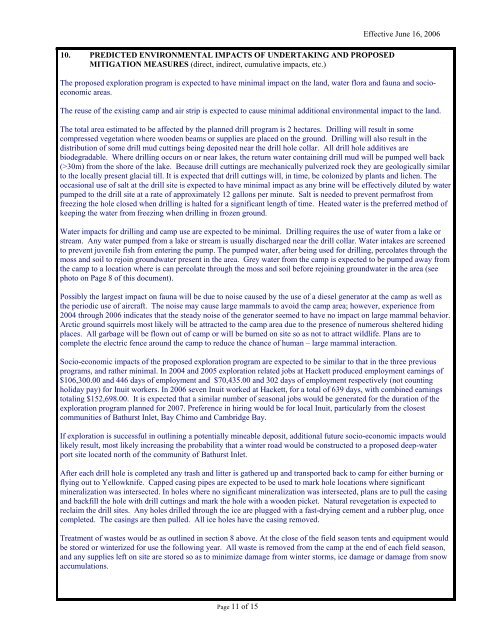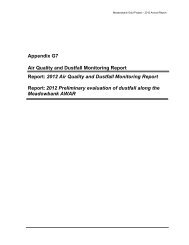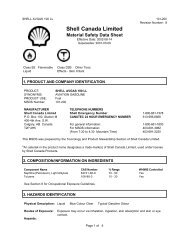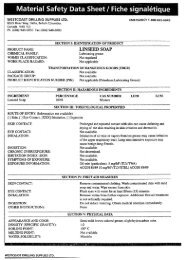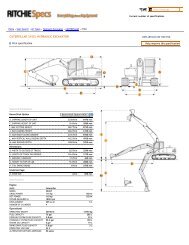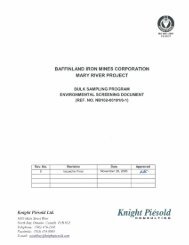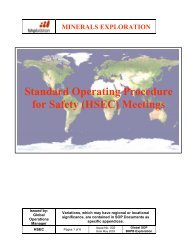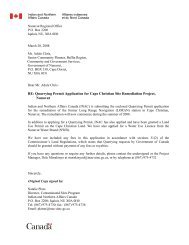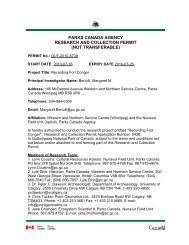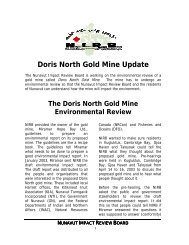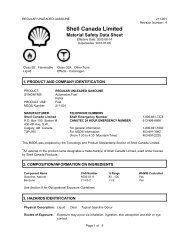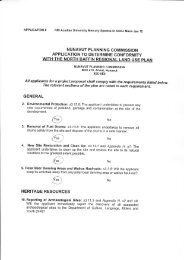080121-08MN006-Sabina Hackett River Project Proposal ... - NIRB
080121-08MN006-Sabina Hackett River Project Proposal ... - NIRB
080121-08MN006-Sabina Hackett River Project Proposal ... - NIRB
Create successful ePaper yourself
Turn your PDF publications into a flip-book with our unique Google optimized e-Paper software.
10. PREDICTED ENVIRONMENTAL IMPACTS OF UNDERTAKING AND PROPOSEDMITIGATION MEASURES (direct, indirect, cumulative impacts, etc.)Effective June 16, 2006The proposed exploration program is expected to have minimal impact on the land, water flora and fauna and socioeconomicareas.The reuse of the existing camp and air strip is expected to cause minimal additional environmental impact to the land.The total area estimated to be affected by the planned drill program is 2 hectares. Drilling will result in somecompressed vegetation where wooden beams or supplies are placed on the ground. Drilling will also result in thedistribution of some drill mud cuttings being deposited near the drill hole collar. All drill hole additives arebiodegradable. Where drilling occurs on or near lakes, the return water containing drill mud will be pumped well back(>30m) from the shore of the lake. Because drill cuttings are mechanically pulverized rock they are geologically similarto the locally present glacial till. It is expected that drill cuttings will, in time, be colonized by plants and lichen. Theoccasional use of salt at the drill site is expected to have minimal impact as any brine will be effectively diluted by waterpumped to the drill site at a rate of approximately 12 gallons per minute. Salt is needed to prevent permafrost fromfreezing the hole closed when drilling is halted for a significant length of time. Heated water is the preferred method ofkeeping the water from freezing when drilling in frozen ground.Water impacts for drilling and camp use are expected to be minimal. Drilling requires the use of water from a lake orstream. Any water pumped from a lake or stream is usually discharged near the drill collar. Water intakes are screenedto prevent juvenile fish from entering the pump. The pumped water, after being used for drilling, percolates through themoss and soil to rejoin groundwater present in the area. Grey water from the camp is expected to be pumped away fromthe camp to a location where is can percolate through the moss and soil before rejoining groundwater in the area (seephoto on Page 8 of this document).Possibly the largest impact on fauna will be due to noise caused by the use of a diesel generator at the camp as well asthe periodic use of aircraft. The noise may cause large mammals to avoid the camp area; however, experience from2004 through 2006 indicates that the steady noise of the generator seemed to have no impact on large mammal behavior.Arctic ground squirrels most likely will be attracted to the camp area due to the presence of numerous sheltered hidingplaces. All garbage will be flown out of camp or will be burned on site so as not to attract wildlife. Plans are tocomplete the electric fence around the camp to reduce the chance of human – large mammal interaction.Socio-economic impacts of the proposed exploration program are expected to be similar to that in the three previousprograms, and rather minimal. In 2004 and 2005 exploration related jobs at <strong>Hackett</strong> produced employment earnings of$106,300.00 and 446 days of employment and $70,435.00 and 302 days of employment respectively (not countingholiday pay) for Inuit workers. In 2006 seven Inuit worked at <strong>Hackett</strong>, for a total of 639 days, with combined earningstotaling $152,698.00. It is expected that a similar number of seasonal jobs would be generated for the duration of theexploration program planned for 2007. Preference in hiring would be for local Inuit, particularly from the closestcommunities of Bathurst Inlet, Bay Chimo and Cambridge Bay.If exploration is successful in outlining a potentially mineable deposit, additional future socio-economic impacts wouldlikely result, most likely increasing the probability that a winter road would be constructed to a proposed deep-waterport site located north of the community of Bathurst Inlet.After each drill hole is completed any trash and litter is gathered up and transported back to camp for either burning orflying out to Yellowknife. Capped casing pipes are expected to be used to mark hole locations where significantmineralization was intersected. In holes where no significant mineralization was intersected, plans are to pull the casingand backfill the hole with drill cuttings and mark the hole with a wooden picket. Natural revegetation is expected toreclaim the drill sites. Any holes drilled through the ice are plugged with a fast-drying cement and a rubber plug, oncecompleted. The casings are then pulled. All ice holes have the casing removed.Treatment of wastes would be as outlined in section 8 above. At the close of the field season tents and equipment wouldbe stored or winterized for use the following year. All waste is removed from the camp at the end of each field season,and any supplies left on site are stored so as to minimize damage from winter storms, ice damage or damage from snowaccumulations.Page 11 of 15


